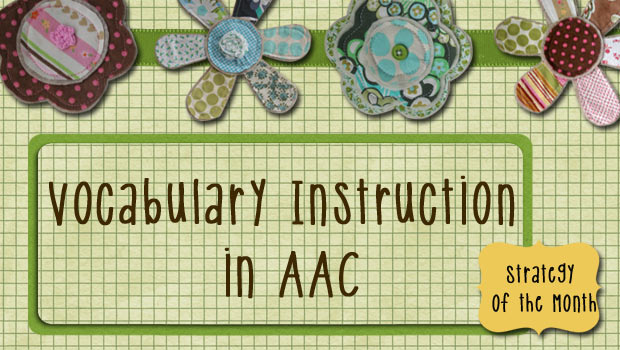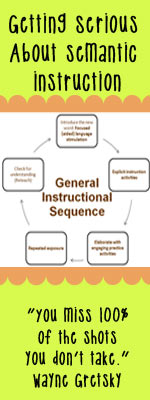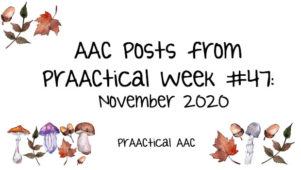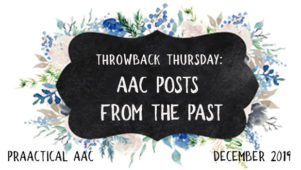Vocabulary Instruction In AAC

For all of us, the process of how we learn to use words begins with the expression of our own intents. Initially, we use words, pictures, or signs to make our wants/needs known but that soon develops into social exchanges, true conversations, stories, and more. For some of our AAC friends, the path to a rich lexicon can be convoluted and bumpy. Our November Strategy of the Month posts will focus on vocabulary instruction giving both general principles that should guide our teaching and specific considerations for communicators at different levels.
As SLPs, we should be champions for a comprehensive approach to semantic instruction in AAC. Much of what we already know for teaching semantics to people who speak can be applied quite nicely to individuals with AAC needs. Certainly some things will need to be adapted, but that’s not the real issue. We’ve noticed that SLPs sometimes forget to apply the wealth of knowledge they already possess about vocabulary instruction. We get distracted by the ‘AAC-ness’ of the situation, and lose touch with what we really know: how to teach language.
Vocabulary teaching is woefully under-represented in the AAC work that we do. What we DO remember and apply often focuses on assessment. We administer tests for single word vocabularies (receptive and expressive), measure lexical diversity using type-token ratios, etc. Our vocabulary goals are often limited to receptive identification or the use of basic descriptors, such as color or size. But our teaching doesn’t always follow the recommended practices for vocabulary development that have come out of research with typical language learners and students with special needs.
We think it can be helpful to revisit our roots and take a second look at some of the guiding principles for semantic instruction. I highly recommend Bringing Words to Life: Robust Vocabulary Instruction (Beck, McKeown, & Kucan, 2002) for anyone who wants a good overview and a common sense perspective on how to help children increase their word knowledge. In the meantime, here are some things to think about as we set off on our lexical safari.

- Context is key. Real word learning doesn’t occur in isolation or via discrete tasks. While this is true for all learners, it is especially important for beginning communicators who do best when our intervention is drenched in a meaningful context with highly overt objects and actions. Experiential learning is critical, particularly for learners at the early stages of language development.
- Vocabulary learning is best approached in a multifaceted way. We don’t learn new word meanings in a single activity. Rather it is a combination of exposure to new words in context, experiential activities with active participation, explicit instruction, and many opportunities for practice with feedback.
- Explicit vocabulary instruction should be a part of every AAC learner’s intervention program. No one is too anything to benefit from activities specifically designed to teach new word meanings. SLPs should have at least one goal for semantic development for each of their AAC learners.
- Aided language input is necessary but not sufficient for new word learning to occur. It is a powerful foundation upon which we can build a platform for explicit semantic instruction.
- Vocabulary instruction is the perfect place for SLPs to impact literacy learning. To be able to comprehend a passage, you have to understand the words within it. To be able to write cohesively, you must have a bank of words that you know and can use.
Throughout this month, we’ll be advocating for an increased role of a robust vocabulary approach in AAC intervention. Here is a general sequence of how we conceptualize semantic instruction.
STEP 1: Introduce the new word(s) using focused AIDED language stimulation
STEP 2: Teach the new word(s) with explicit instruction activities
STEP 3: Elaborate on the new word meanings with engaging practice activities
STEP 4: Provide repeated exposure to the new word(s) on an ongoing basis
STEP 5: Check for understanding and reteach, as necessary.
Does it sound too hard? It’s not. Are your AAC learners too __ [‘low functioning,’ impaired, challenged] for this approach? They’re not. Later this week, we’ll discuss this approach in more detail to elaborate on each of the steps. In the meantime, we’ll leave you with a few quotes that have inspired us to continually improve our knowledge and skills in vocabulary teaching.
::::::::::::::::::::::::::::::::::::::::::::::::::::::::::::::::::::::::::::::::::::::::::::::::::::::::::::::::::::::::
“As vocabulary is reduced, so are the number of feelings you can express, the number of events you can describe, the number of the things you can identify. Not only understanding is limited, but also experience. Man grows by language. Whenever he limits language he retrogresses!” (Tepper, 1993)
::::::::::::::::::::::::::::::::::::::::::::::::::::::::::::::::::::::::::::::::::::::::::::::::::::::::::::::::::::::::
“A man with a scant vocabulary will almost certainly be a weak thinker. The richer and more copious one’s vocabulary and the greater one’s awareness of fine distinctions and subtle nuances of meaning, the more fertile and precise is likely to be one’s thinking. Knowledge of things and knowledge of the words for them grow together. If you do not know the words, you can hardly know the thing.” (Hazlitt, 1916)
::::::::::::::::::::::::::::::::::::::::::::::::::::::::::::::::::::::::::::::::::::::::::::::::::::::::::::::::::::::::
“Knowledge unused tends to drop out of mind. Knowledge used does not need to be remembered; Practice forms habits and habits make memory unnecessary. The rule is nothing; the application is everything.” (Hazlitt, 1916)
::::::::::::::::::::::::::::::::::::::::::::::::::::::::::::::::::::::::::::::::::::::::::::::::::::::::::::::::::::::::
Beck, I. L., McKeown, M. G., & Kucan, L. (2002). Bringing words to life: Robust vocabulary instruction. New York: The Guilford Press.
Filed under: Strategy of the Month
Tagged With: intervention, new words, semantics, strategy, vocabulary, word learning
This post was written by Carole Zangari





9 Comments
I’m so excited by this months topic! And thank you so much for this blog – such a wonderful resource for practical, balanced AAC implementation advice with high expectations for all.
I rushed to Amazon.com for the Bringing Words to Life, which I am not familiar with, and found that the second edition is being released 2/22/13: http://amzn.to/YjHRMN Am wondering if I can wait that long!
Ooh! Great find, Jennifer!! I’ve had a couple of copies over the years that have gotten dog-eared and tabbed to death. Maybe Santa will bring me the new edition. 🙂 Thanks for your kind words about the blog. I’m excited about this topic, too. This is one of my favorite parts of language therapy so it is really fun to write these posts.
Another great post. You and Robin are my heroes!
Thanks, Jeanne! But it’s people like you who do the ‘roll up your sleeves and get to it’ work of AAC who are the real heroes.
I am good with words.
The older I get, the more I appreciate the gift of words and being able to reach others that way. It’s up to all of us to find ways to support the people who still struggle to express themselves. Thanks for stopping by to read this post and for your comment, Anna. Much appreciated.
Hi! I am so interested and wondering if there was a follow up to this post. did you ever end up posting the more elaborate explanations of each step? Bringing Words to Life was an inspiration to me in Grad School and I am very interested in how to use these concepts with the AAC population. Thank you so much!
Hi Jessica. Thanks for your comment. Yes, we did a lot of posts on vocab instruction after this one. Here are some of them: http://praacticalaac.org/praactical/aac-vocabulary-instruction-round-up/
Hi Carole,
I am just starting out with core instruction, so I might have your entire website read at some point! I am working with 2 essentially nonverbal 3 y/o kids. They can say some animal names and imitate hi/bye, but that’s it. When teaching core vocabulary to this population, I am starting with boards with 8 or 16 words. Should I teach the words one at a time or in a functional phrase, such as “I want it.” I find it hard to conceptualize teaching a word like “it” because it is so nonspecific.
Thanks!